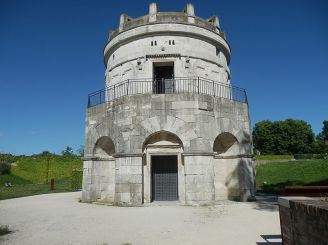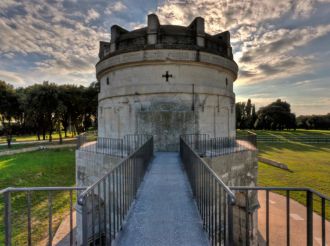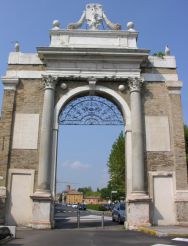Mausoleum of Galla Placidia, Ravenna
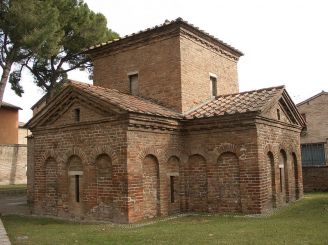
The Mausoleum of Galla Placidia (Mausoleo di Galla Placidia) is one of the most ancient and valuable historical heritage sites of Ravenna. Besides that, it is considered to be one of the most significant landmarks that date back to the early Christian times. The building is famous for, first and foremost, its fascinating religiously and historically themed mosaics. The old mausoleum is included into the list of World Heritage Sites.
History of the Mausoleum of Galla Placidia
This ancient construction boasts a ripe old age of 1600. It was finished in the first half of the 5th century allegedly. It was supposed to be a tomb for Galla Placidia, the daughter of the last Roman emperor Theodosius I. However, it never served its intended purpose since the woman was buried in an ancestral tomb, in Rome, in 450. After that, the mausoleum was used as a chapel at the old church called Santa Croce that was built around 417. Part of the church meant for worshipping was dedicated to Saint Lawrence as indicated by the mosaic above the entrance. In the 14th century, the building’s name was finally established. In 1898–1902 restoration works were performed on it, then in 1908, its windows were covered with alabaster tiles. In 1996 the mausoleum, as well as other city monuments that belonged to the early Christian epoch, were listed as World Heritage site.
Exterior and interior design
From the outside, the building appears to be quite simple, even a bit primitive. It resembles a fortress due to the heavy walls and narrow windows. The mausoleum was shaped as the Christian cross (12,75x10,25 meters.) Its walls are made of refractory bricks, the roof is covered in tiles. A square tower in the center rises above the building. Interestingly, a bell is hidden inside it that you cannot see from the outside. There are 14 windows in total, they look like arrowslits. The façade is decorated with arches and small vertical ledges. A frieze with two panthers and vines can be found at the entrance.
Mausoleum’s interior stands in stark contrast with the outer simplicity. The lower part of the walls is faced with light yellow marble. A soft sunglow pours from the windows highlighting the wonderful beauty of the mosaics that decorated impressive vaults and the central mausoleum dome.
Mosaics and sarcophagi
The mosaics are of great significance for the world cultural heritage. They belong to different artists, and their themes are pretty varied. Despite that, they fuse into something whole. The mosaics are fancy and decorate the mausoleum’s entire upper half. Each one of them should be addressed separately:
- Dome and vault. The central dome is embellished with a mosaic that illustrates a starry sky. A golden crest in the center and 800 stars can be found on the blue background. This is meant to symbolically state Jesus Christ’s superiority. You might also notice symbolical depictions of 4 authors who wrote Gospels on each side. They are portrayed as animals (lion, calf, eagle) and an angel. There is also a complex geometrical ornament that represents the Garden of Eden painted around the dome.
- Apostles. They are depicted in 4 lunettes, above the windows. However, there are only eight apostles out of 12. It was done this way to maintain symmetry. Christ’s disciples are standing in Roman senators’ clothing with hands raised to the starry sky on the ceiling. Every each of them possesses own, specific facial features, their bodies are slightly turned.
- The northern lunette. Here visitors can find Jesus depicted as a young man, a shepherd whose attention is focused on the sheep that are wandering around him. Christ is sitting in a golden chiton on a small hill that symbolizes a throne with a crest in hands and purple coat on his lap.
- Southern lunette. Here a mosaic portrays next: a man dressed in white clothes is holding a crest and a book and heading towards bonfire, a bookshelf that contains 4 Gospels is shown on the left. The most popular theory says that the man is Saint Lawrence who sacrificed himself for Jesus.
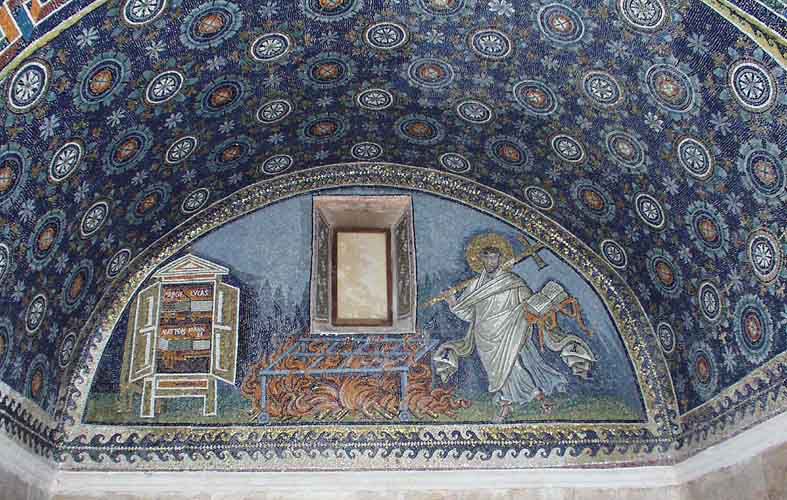
Besides the mosaics, the interiors also boast three ancient marble sarcophagi. Allegedly, they were meant for Galla Placidia herself, her son Valentinian III and spouse Constantius III. Currently, it is not possible to ascertain precisely the names of the people once buried here or the dates. In 1577 the central sarcophagus caught on fire after a candle was dropped into it that curious local children brought with them. As a result, almost everything was burned down, charred bone and skull remains, and cypress throne somewhat survived through this. Two other sarcophagi are decorated richly compared to the main one. They were opened in 1738. Relics of a man and woman were discovered inside both.
How to get
The Mausoleum of Galla Placidia is located in the northern part of Ravenna’s historical center, on Via San Vitale, 17. The Ravenna National Museum is situated very close to it, Porta Adriana can be found a little farther. There is also other religious constructions in the city which you can enter with the mausoleum ticket, these include the Baptistery of Neon, the basilicas of Sant' Apollinare Nuovo and San Vitale, Archiepiscopal Museum. The nearest bus stop is Piazza Baracca (bus №70) that is 5 minutes away.
Opening hours: from November to February from 10:00 till 17:00, from March to October from 09:00 till 19:00. The ticket office closes 15 minutes before the closing time. Contact number: (+39) 0544 541688.
Admission: a full ticket costs 9,5 euros, a reduced one – 8,5 euros (available for students and groups of 20 people and more.) Children under 10 and persons with disabilities are free of charge.



